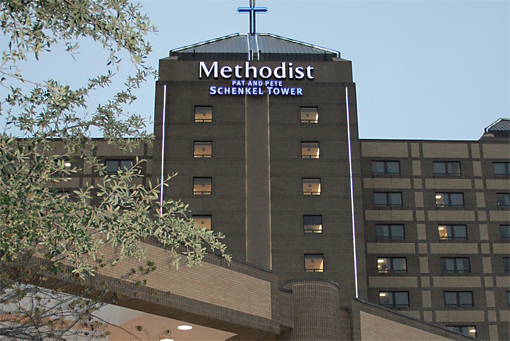| 제목 | [DAIKIN] HEALTHCARE - Methodist Dallas Medical Center | 작성일 | 16-06-16 14:00 |
| 글쓴이 | 최고관리자 | 조회수 | 2,831 |
본문
Methodist Dallas Medical Center achieved an 18-month payback on a new HVAC system that includes a 2,000-ton Daikin dual-compressor centrifugal chiller.
CASE STUDY
Healthcare Facility
Name
Methodist Dallas Medical Center
Location
Dallas, TX USA
Facility Size
100,000 ft2 medical offices and outpatient facility
Issue
A large central utility plant with over-taxed HVAC systems
Solution
Daikin 2,000 ton dual compressor centrifugal chiller
"Total systems approach" helps Methodist Dallas Medical Center achieve 18-month payback for new HVAC system
With large central utility plants, over-taxed HVAC systems and ever-increasing utility costs, many hospitals face the dual problems of high energy costs and compromised environmental air quality. By taking a "total systems approach" to energy management, hospital engineers at Methodist Dallas Medical Center (MDMC) were able to solve these problems with a new turnkey central utility plant that significantly reduced energy costs and restored air quality. Central to the plan's success are a new Daikin 2,000- ton dual-compressor centrifugal chiller, variable frequency drives and new controls that gave the hospital an 18-month return on the investment while saving seven percent in utility costs.
Founded in 1927, the 500-bed Methodist Dallas Medical Center serves more than 160,000 patients a year and has received a Gold Seal of Approval® from the Joint Commission on Accreditation of Healthcare Organizations. An expansion project that will add a 100,000-square-foot medical office building and update existing outpatient facilities will bring the total space to more than one million square feet.
Hospital sought solution for "hot spots"
The previous HVAC system serving the facility included one 1,400-ton, one 1,100-ton and one 650-ton centrifugal chiller. Although just 15 years old, the existing HVAC system was unable to handle the increased cooling load at the expanding hospital.
Hospital staff complained about "hot spots," especially in areas farthest from the central utility plant. In addition, the hospital was facing significant increases in energy costs due to increased gas costs as well as increased transmission and distribution costs.
"We had run out of chiller capacity," said Charlie Shoup, assistant administrator for engineering and safety, Methodist Dallas Medical Center. "The chillers were running at 100 percent 24/7 for three months in the summer. "We got to the point where the central utility plant was not able to produce the required 42°F chilled water. During hot summer months, we could only produce 50°F chilled water." Both the chilled water and condenser water flows were out of acceptable range due to improper pump calibrations. As a result, the air handling units could not produce the leaving air temperatures needed to control humidity. This affected environmental comfort throughout the hospital.
Although the immediate "culprits" appeared to be the mismatched chillers and pumps, fixing them would have solved only part of the problem. "We wanted a best-case scenario and a long-term solution," said Shoup.
Total solutions approach helped achieve goal
Shoup and his staff had been working with Ron Green, president and founder of Energy Integrators, Inc., Dallas, an independent energy consulting firm, to develop a long-term utility management plan that would reduce energy consumption and the hospital's overall carbon footprint. Already in place was a water management program that Energy Integrators, Inc. had developed for the hospital. To develop a holistic utility management program, the energy firm first conducted a baseline energy review looking at 10 key areas of energy management. The second step was to conduct a plant review to identify both potential technical as well as operational improvements. The identified actions were prioritized and rolled out as a series of 90-day plans. This "total systems approach" gave hospital officials a comprehensive fix that substantially increased the benefits for the hospital as a whole.
"People often look at energy management as a technical fix of simply changing out a chiller or upgrading the lights," said Green. "Our goal is to establish a systems approach to facility management— that is, integrate the operational, technical and environmental issues into the overall management systems of the facility. The HVAC project was one key element of an overall strategic plan to reduce energy and the hospital's carbon footprint.
"By looking at all the elements and issues of energy management, you avoid the typical roller-coaster effect caused by reactive responses to increasing costs. When you have an overall strategic utility management plan in place, events that you can't control, such as a spike in utility costs or potential carbon taxes, won't affect you as much," said Green.
With the utility management plan in hand, Shoup consulted with Texas Air Systems, Dallas, a manufacturers' representative for Daikin HVAC equipment, to determine the best HVAC solution. "Once we knew that we had to get the chilled water and condenser water flows back in sync, we considered additional ways to reduce energy use while still producing our required chilled water temperature. It wouldn't be just one thing that would improve this; we had to consider the entire system," he said. "The plant also needed to provide redundancy, because a hospital cannot be without air conditioning."
The three-part solution provided the complete package: 1) new variable frequency drives installed on the chilled water and condenser water pumps corrected the flow through evaporators and condensers; 2) new controls measured and regulated the flows on the primary and secondary loops; and 3) the new 2,000-ton Daikin dual-compressor centrifugal chiller delivered significant energy savings as well as a small physical footprint, with the added benefit of minimal downtime during the replacement.
Chiller part-load efficiency contributes to overall results
"The Daikin chiller has the highest efficiency rating at 50 to 75 percent of full load, and that's why we chose it," said Shoup. The new 2,000- ton chiller replaces both the 1,400- and 1,100-ton chiller, for a new combined tonnage of 2,650 tons. It fits in the same footprint as the larger chillers and uses R-134a refrigerant. And, with the help of the Invensys® building automation system, we have much more control. Our chillers communicate with the Invensys system using LonTalk® open standard communications protocol, and we control chiller operation according to load and demand."
For maximum energy savings, a new sequence of operation directs the chillers to match load and conditions precisely, providing correct pump flows for both chilled water and condenser water systems. It is now possible to deliver 42°F leaving water temperature when required, during both lower load and ambient conditions. Chilled water reset strategies are also in place.
The result for staff and patient comfort is consistent temperatures and humidity levels. "Once we had the new chiller in place, there was a noticeable improvement in indoor air temperature," said Shoup. "Our original estimate was for a three-year payback, and we thought that would be pretty good," said Shoup. "But with the kilowatt-hours that we saved due to higher efficiency, the system paid for itself in 18 months. We're getting maximum energy savings and providing increased comfort throughout the hospital. What could be healthier than that?" said Shoup.
Daikin Applied delivers engineered, flexible solutions for commercial, industrial and institutional HVAC requirements with reliable products, knowledgeable applications expertise and responsive support. Daikin products and services are provided through a worldwide network of dedicated sales and service offices.
| 이전글 | [DAIKIN] HEALTHCARE - Robert C. Hudson Memorial Office Building 2016-06-16 | ||
| 다음글 | [DAIKIN] HEALTHCARE - Ohio Veterans Home 2016-06-16 | ||






